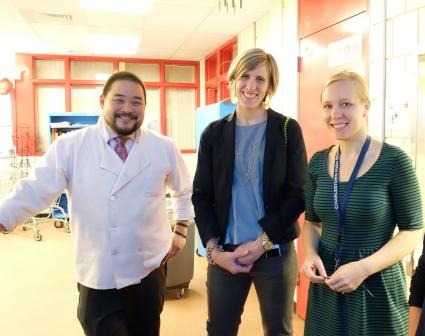Research & Insights / Close Up on Charlestown High: Using Video to Create Time for Teachers
Close Up on Charlestown High: Using Video to Create Time for Teachers

By Alexander Kalamaroff
Of all the resources a school can have, the most valuable (alongside money) is time—time for teachers to plan, to grade, to make calls home, to observe each other’s classrooms, and to think big picture about what instruction means at our schools. Yet there is never enough time in any given school day.
At Charlestown High School, we identified this lack of time as a critical problem. We knew we needed time for teachers to reflect on their practice and to observe their colleagues' teaching, as self-reflection and peer observation are proven tools in improving instruction—but when, and how? We found our answer in low-cost video-recording and digital technology. Such technology, when intentionally employed, can create new opportunities for individual teacher growth and school-wide improvement, which can have dramatic effects on the instructional climate of a school as a whole.
In January 2015, we received a grant from EdVestors’ School Solutions Seed Fund to enable teachers to film themselves teaching using a $200 video camera mounted on a tripod. These videos are uploaded to a Google Drive folder, which is shared with a four-person study group of fellow teachers. Teachers watch video of themselves teaching and then meet as a group and watch short, five-minute clips from each other’s videos. Using a previously agreed-upon Focus Area that the teachers themselves identified as their guide, they talk, they brainstorm, they learn from one another, and they learn more about instruction across our school. They see what is happening in their colleagues’ classrooms—something that is often impossible during the tightly scheduled school day.
These discussions are non-evaluative. The goal is honest and earnest reflection about how to improve one’s practice.
“There is this gap,” says Kati Delahanty, Charlestown High’s Director of Instruction, “between what is covered broadly in professional development and what happens in classrooms. There is also often a gap between what teachers believe to be happening in their classrooms and what is actually happening.”
This latter gap can be something simple, such as “wait time,” where teachers frequently overestimate the time they give students to think before answering a question (five seconds can feel like a minute when you’re in front of the class), to much more complex issues, such as “equity of participation,” where some students can be unintentionally left-out or not fully engaged without a teacher noticing.
Being able to look honestly and earnestly at your own classroom and your colleagues’ classroom is the first step in overcoming these gaps. As one participating teacher said, “The experience of observation can be scary, but this experience has been inspiring and joyful.”
Over the past two years, we experimented with this project and worked diligently to overcome technological hiccups while simultaneously thinking about how to maximize the impact of this work.
What We Learned

1. Structure discussions enough so that everyone stays on track but not so much that it stifles free-wheeling creativity and brainstorming
Initially, our discussions around self-reflection were so open-ended there were not always enough clear-cut “take-aways” that teachers could immediately implement in their classrooms. Over time, we structured these discussions, with one member of the group taking on the role of Facilitator of Reflection.
2. Keep the technology as simple as possible
At first, we hired a videographer and had plans to do video-editing as well. None of this was truly necessary. The video footage of teachers doesn’t need to be shot by Orson Welles. It just needs to accurately show what is happening in our classrooms.
3. Pursue incremental growth in students—and staff
We long for epiphanies, for “ah-ha” moments where everything “clicks.” But such moments rarely occur, and when they do it’s only after the foundation has been set and people have put in the long, hard work of getting better slowly, over time. Don’t expect teachers’ practices to change overnight. Instead, look for measurable signs of growth on a daily basis.
4. Honor teachers’ time no matter what (or as much as is realistically possible)
At our school, we try—but often fail—to protect teachers’ time. There are so many demands on teachers’ time that ultimately distract from the primary job of classroom instruction. If we want teachers to improve, we need to give them the time, the space, and the opportunity to do so individually and collectively.
Our goal now, going into our third year of this work, is to embed this practice more fully into our school-day schedule, into our Content Teams and coaching model, while at the same time keeping these discussions around self-reflection and peer observation teacher-driven, honest, and true.
To learn more about this initiative, please contact Alex Kalamaroff of Charlestown High at akalamaroff@bostonpublicschools.org. For more information about Charlestown High School, click here.



